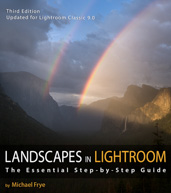In the Moment:
Michael Frye's Landscape Photography Blog
by Michael Frye | Dec 24, 2022 | Announcements
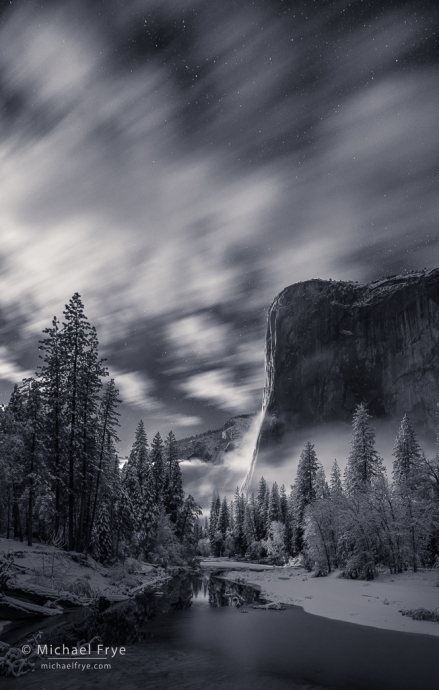
Moonlit clouds over El Capitan, Yosemite
While snow is rare at our house in the Sierra foothills, Yosemite Valley has received a few early-winter snowstorms, so Claudia and I have been able to go up there and enjoy the snow on several occasions, which is always a treat. To me, the holidays always feel more festive with snow. I made this photograph of El Capitan after one of those storms, as the setting moon lit El Capitan and the fast-moving clouds overhead.
For many people in North America, however, things probably seem a bit too wintry. It’s one thing to watch snowflakes floating gently to the ground outside while you sit around a cozy fire; it’s another to endure blizzard conditions, whiteouts, sub-zero temperatures, flight delays, and power outages.
Claudia and I hope everyone is able to stay safe, and warm, and to spend time with their loved ones (at least eventually) during this holiday season. Whatever the circumstances, we hope you’re able to make the best of things, and wish you a very Merry Christmas and Happy Hanukkah.
— Michael Frye
by Michael Frye | Dec 21, 2022 | Light and Weather
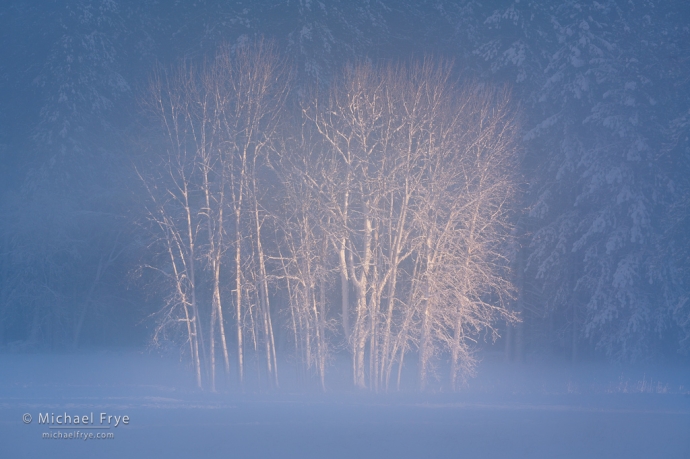
Cottonwoods in late-afternoon light, Yosemite NP, California
We’ve had a great start to the winter here in the Sierra, with several early-December storms bringing rain and higher-elevation snow. Precipitation is above average for Yosemite Valley at this point, which is wonderful. Some other recent winters have also gotten off to a strong start only to fizzle in January and February, so we’ll keep our fingers crossed that this winter will be different.
This winter’s early-season storms have been on the cold side, cold enough to bring snow to Yosemite Valley several times. The most recent storm (December 10th and 11th) followed a typical pattern, starting with rain in Yosemite Valley (at 4,000 feet), then changing to snow toward the end of the system as the cold front moved through. That tail end was pretty strong, dumping about eight to nine inches of new snow on the valley floor.
(more…)
by Michael Frye | Nov 20, 2022 | Light and Weather, Vision and Creativity
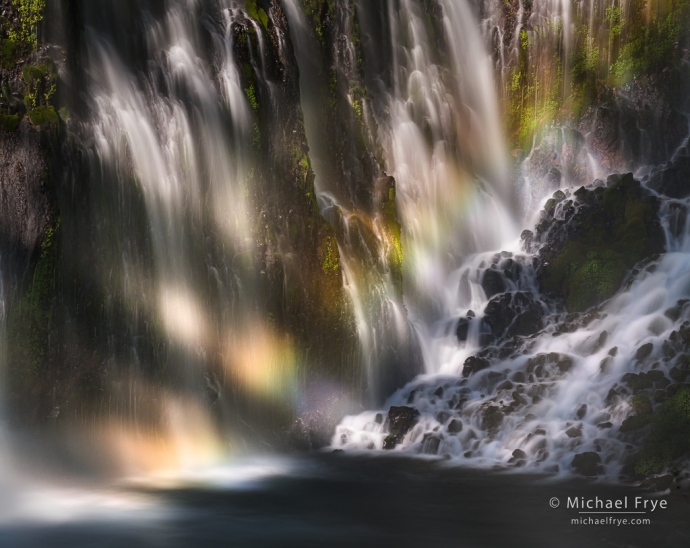
Tree shadows, rainbow, and waterfall, California. Claudia and I photographed this waterfall in soft light the evening before, but I came back the next morning hoping to see tree shadows when the sun got high enough. And sure enough, eventually trees cast beautiful striped shadows across the fall, creating a sunbeam-like effect. But I didn’t expect to also see a rainbow interspersed with the tree shadows – a nice bonus. I used a telephoto lens to fill the frame with the most eye-catching part of the scene, a polarizer to enhance the rainbow, and a neutral-density filter to slow down the shutter speed and give the water a soft, silky appearance. 135mm, 3 seconds at f/16, ISO 100, polarizer, ND filter (probably a 7-stop filter).
I love waterfalls. Who doesn’t? Besides their beauty, large waterfalls cast negative ions into the air, and negative ions supposedly have health benefits – making people feel refreshed and renewed, helping regulate sleep patterns and mood, reducing stress, and boosting the immune system. Or not; the scientific evidence is mixed at best. But whatever the reason, people seem magnetically drawn to waterfalls.
And of course waterfalls are quite photogenic. Over the past year I’ve had the opportunity to visit several waterfalls I’ve never photographed before. And while soft light usually works for waterfalls, I tried to seek out more unusual lighting conditions that could give the photographs a different look and feeling. That meant using sunlight, but waterfalls usually reside in basins and canyons, so they don’t often get that warm, low-angle light that we’re often looking for. And when the sun does get high enough to strike the fall, it’s often filtered through trees, creating splotchy light. Splotchy light can be harsh and downright awful, but sometimes, under the right circumstances, it can work. And – again, under the right circumstances – backlight can highlight a waterfall’s spray. And while front light is usually flat and boring, with waterfalls it can create rainbows.
(more…)
by Michael Frye | Nov 13, 2022 | Travels and Stories
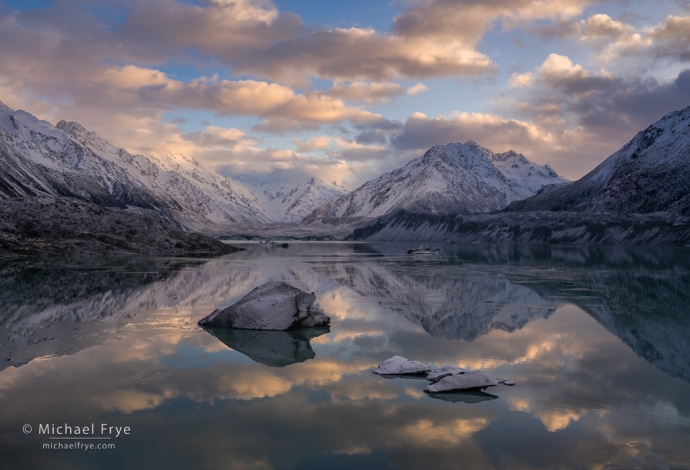
Sunrise at a glacial lake, New Zealand. It was a treat to photograph this glacial lake, complete with icebergs – something I don’t get to do in California! And with fresh snow to boot.
New Zealand’s South Island is remarkably diverse. It’s an area about the size of Colorado, yet contains temperate rain forests, dry grasslands, enormous natural lakes, and lots of beautiful coastline, including its renowned fiords.
And to top if off (literally), there’s also a range of high, snowy mountains – the Southern Alps. These mountains aren’t terribly high compared to some other ranges. The tallest peak, Aoraki / Mt. Cook, is “only” 12,218 feet (3,724 meters) above sea level. Compare that to Mt. Whitney, in my home mountains, the Sierra Nevada, at 14,505 feet (4,421 meters) – the tallest peak in the contiguous United States (the “lower 48”).
(more…)
by Michael Frye | May 17, 2022 | Night Photography, Travels and Stories

Blue oak and eclipsed moon, Sierra Nevada foothills, California. 122mm, 1 second at f/11, ISO 6400.
On Sunday a total lunar eclipse was visible in many parts of the world, including our corner of California in the Sierra Nevada.
I’ve photographed many lunar eclipses before. I like capturing sequences of the moon above a landscape in various eclipse stages – if possible. But for this eclipse I couldn’t think of any nearby spot that would add a compelling foreground while looking in the right direction (southeast) for a sequence like that, plus it appeared that clouds might interrupt any attempt at capturing a long eclipse sequence.
Instead, I thought of a lone oak tree in the Sierra foothills that might lend itself to a different treatment: a telephoto view of just the tree and eclipsed moon at dusk. I had photographed this tree before, and it looked like the tree and moon would line up well. Using a long lens would make the moon look larger, plus capturing a single frame like this would require only a brief cloud-free interval to work, while a sequence would need several hours of clear skies.
(more…)












